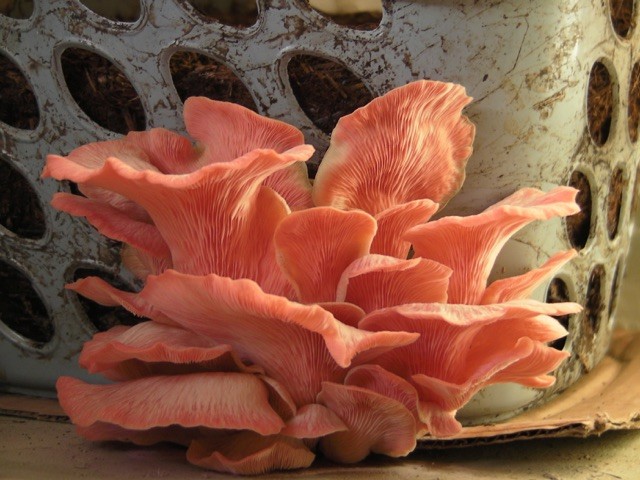
You could spend your entire life studying nothing but fungi, and you would never learn it all. Mushrooms are amazing organisms, and each one has specific food, temperature, humidity, light, and chemical requirements.
Learning to grow mushrooms is a rewarding hobby. It can be a little tricky, especially when you’re first starting out, but it’s worth the effort. Mushrooms are also ideal as part of a food web, as they integrate well into most food systems and can be grown on waste products.
Our guide on growing oyster mushrooms in a laundry basket can help you get started.
It is not recommended to gather wild mushrooms, unless you can provide a 100% positive identification. Instead of collecting from the wild, a better strategy for beginners is buying spawn for species you are interested in.
The world of edibles mushrooms is vast, but we’re going to take a look at a few easy-to-grow species. The key to growing mushrooms efficiently is to pick species that match the natural climate in your home. All mushrooms should be cooked before eating to make the nutrients available for your body. Raw mushrooms have no nutrition available.

Spawn Run: 75F, 85%-95% humidity, 12-21 days
Primordia: 50F-60F, 95%-100% humidity, fresh air 3 times a day, full light, 3-7 days
Fruiting: 60F-70F, 85%-95% humidity, fresh air 3 times a day, full light, 4-7 days
This is the easiest mushroom to grow. It can be cultivated on a wide variety of substrates, including sawdust, straw, paper, cardboard, and even coffee grounds.

Spawn Run: 75F-85F, 90%-100% humidity, 7-10 days
Primordia: 65F-75F, 95%-100% humidity, fresh air 3 times a day, full light, 2-4 days
Fruiting: 70F-85F, 85%-95% humidity, fresh air 3 times a day, full light, 3-5 days
Here’s an oyster species for a warmer climate.

Spawn Run: 70F-80F, 90%-100% humidity, 35-70 days, low light
Primordia: 50F-60F, 95%-100% humidity, fresh air 3 times a day, medium light, 5-7 days
Fruiting: 50F-70F, 60%-80% humidity, fresh air 3 times a day, full light, 5-8 days
Shiitake are a popular species to eat, and they do well on logs and stumps.
Spawn Run: 70F-80F, 90%-100% humidity, 25-45 days
Primordia: 50F-60F, 95%-100% humidity, fresh air 3 times a day, low light, 14-21 days
Fruiting: 60F-70F, 85%-95% humidity, fresh air 3 times a day, low light, 7-14 days
This mushrooms can get big, with a diameter exceeding one foot!

Spawn Run: 75F-95F, 80%-90% humidity, 5-10 days, no light
Primordia: 80F-90F, 90%-100% humidity, fresh air twice a day, low light, 4-6 days
Fruiting: 80F-90F, 85%-95% humidity, fresh air twice a day, low light, 6-10 days
Paddy Straw mushrooms are grown on rotting rice straw. This species does well outdoors in hot, humid climates.
Growing your own medicines is a great way to learn about yourself and natural chemistry. It is a hobby that goes way back into our ancestry. The world of medicinal mushrooms is a big one, and it’s expanding all the time.
Many mushrooms have medicinal properties from boosting your immune system to encouraging nerve growth, and are being recognized by conventional medicine as effective treatments for a wide variety of ailments, from cancer to HIV. Let’s look at some of the most common and easy to grow medicinal mushrooms.

Spawn Run: 75F-85F, 90%-100% humidity, 14-21 days
Primordia: 50F-70F, 95%-100% humidity, fresh air once a day, minimal light, 7-14 days
Fruiting: 65F-75F, 85%-95% humidity, fresh air twice a day, minimal light, 45-70 days
Properties: Medicinal use of Trametes versicolor was first noted in China during the Ming Dynasty. PSK and PSP are protein-bound polysaccharide isolated from Trametes versicolor. PSK is commercially known as “Krestin” and is responsible for hundreds of millions of dollars of sales as an approved cancer drug in Asia. PSK is also a strong antibiotic. PSP has been shown to inhibit HIV replication.

Spawn Run: 70F-80F, 95%-100% humidity, 10-20 days
Primordia: 65F-75F, 95%-100% humidity, fresh air once a day, minimal light, 14-28 days
Fruiting: 70F-80F, 90%-95% humidity, fresh air 3 times a day, increased light, 60 days
Properties: Ganoderma lucidum has been used medicinally for millennia in Asia. Ganoderma lucidum is thought to be useful against chronic bronchitis, inflammation, hyperlipidemia, hypertension, neurasthenia, hepatitis, leukopenia, and as a cancer therapy adjuvant. From Ganoderma lucidum, researchers have isolated over 100 lanostane-type triterpenoids, including ganolucidic, ganoderenic, lucidenic, and ganoderic acids.

Spawn Run: 70F-80F, 90%-100% humidity, 35-70 days, low light
Primordia: 50F-60F, 95%-100% humidity, fresh air 3 times a day, medium light, 5-7 days
Fruiting: 50F-70F, 60%-80% humidity, fresh air 3 times a day, full light, 5-8 days
Properties: Lentinan is an isolate of Lentinula edodes mycelia. Lentinan has been approved for clinical use in Japan for many years, and is manufactured by several pharmaceutical companies. Intraperitoneal lentinan is widely used as an adjuvant treatment for certain cancers in Japan and China. AHCC is a fermented extract of Lentinula edodes mycelia.

Spawn Run: 75F, 85%-95% humidity, 12-21 days
Primordia: 50F-60F, 95%-100% humidity, fresh air 3 times a day, full light, 3-7 days
Fruiting: 60F-70F, 85%-95% humidity, fresh air 3 times a day, full light, 4-7 days
Properties: Pleurotus ostreatus contains lovastatin and pleuran.A number of studies indicate Pleurotus ostreatus consumption lowers cholesterol levels. Research with Pleurotus ostreatus extracts indicate potential anticancer and immunomodulatory activities.

Spawn Run: 75F-85F, 90%-100% humidity, 7-10 days
Primordia: 65F-75F, 95%-100% humidity, fresh air 3 times a day, full light, 2-4 days
Fruiting: 70F-85F, 85%-95% humidity, fresh air 3 times a day, full light, 3-5 days
Properties: Pleurotus djamor extracts have potential immunomodulatory activities.
If you are interested in growing your own medicines, medicinal mushrooms are a great place to start. If treating for a specific condition, buy some online first and see if you notice any effects. Do your research on this subject before growing these mushrooms to increase your chances of success.